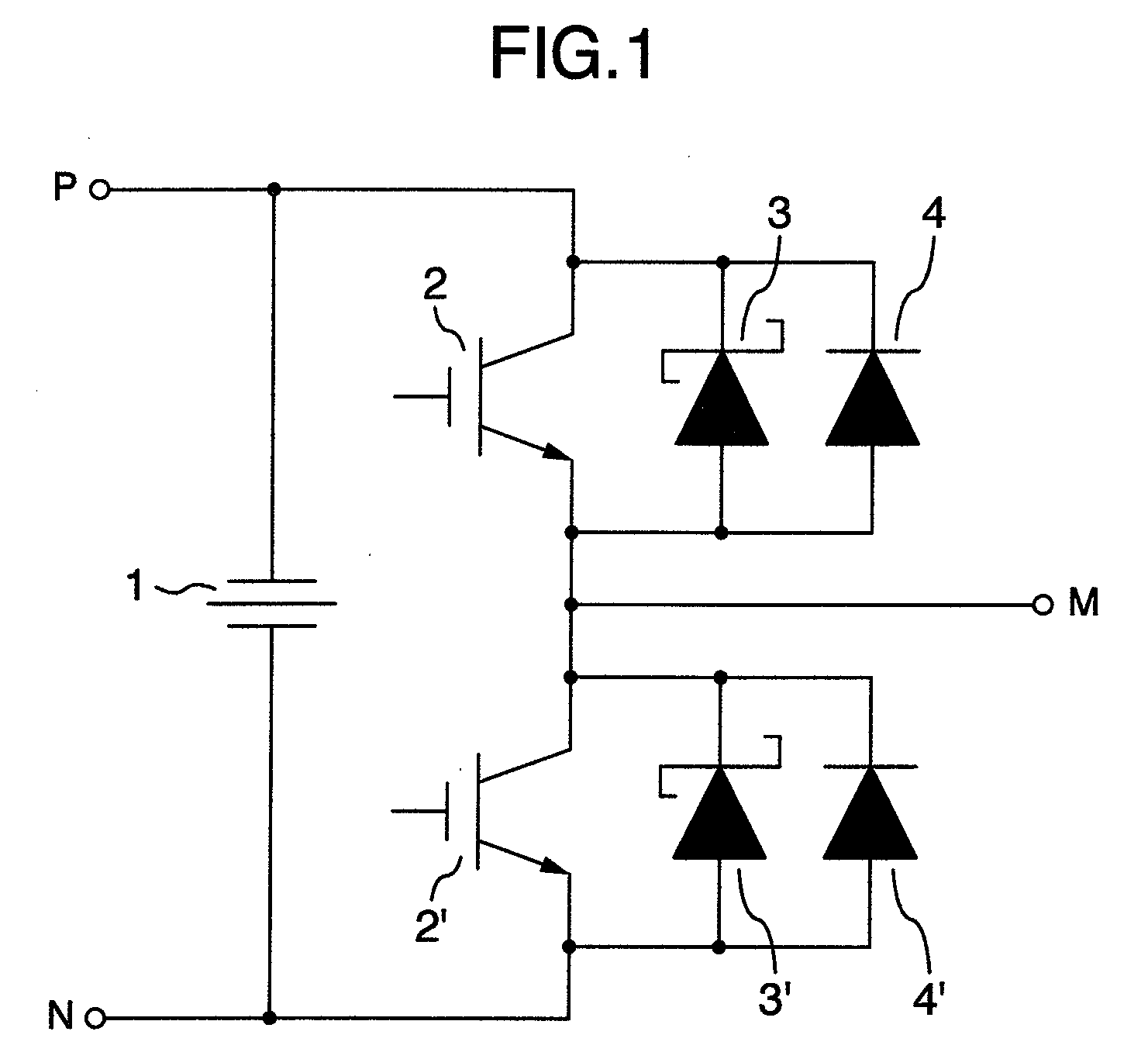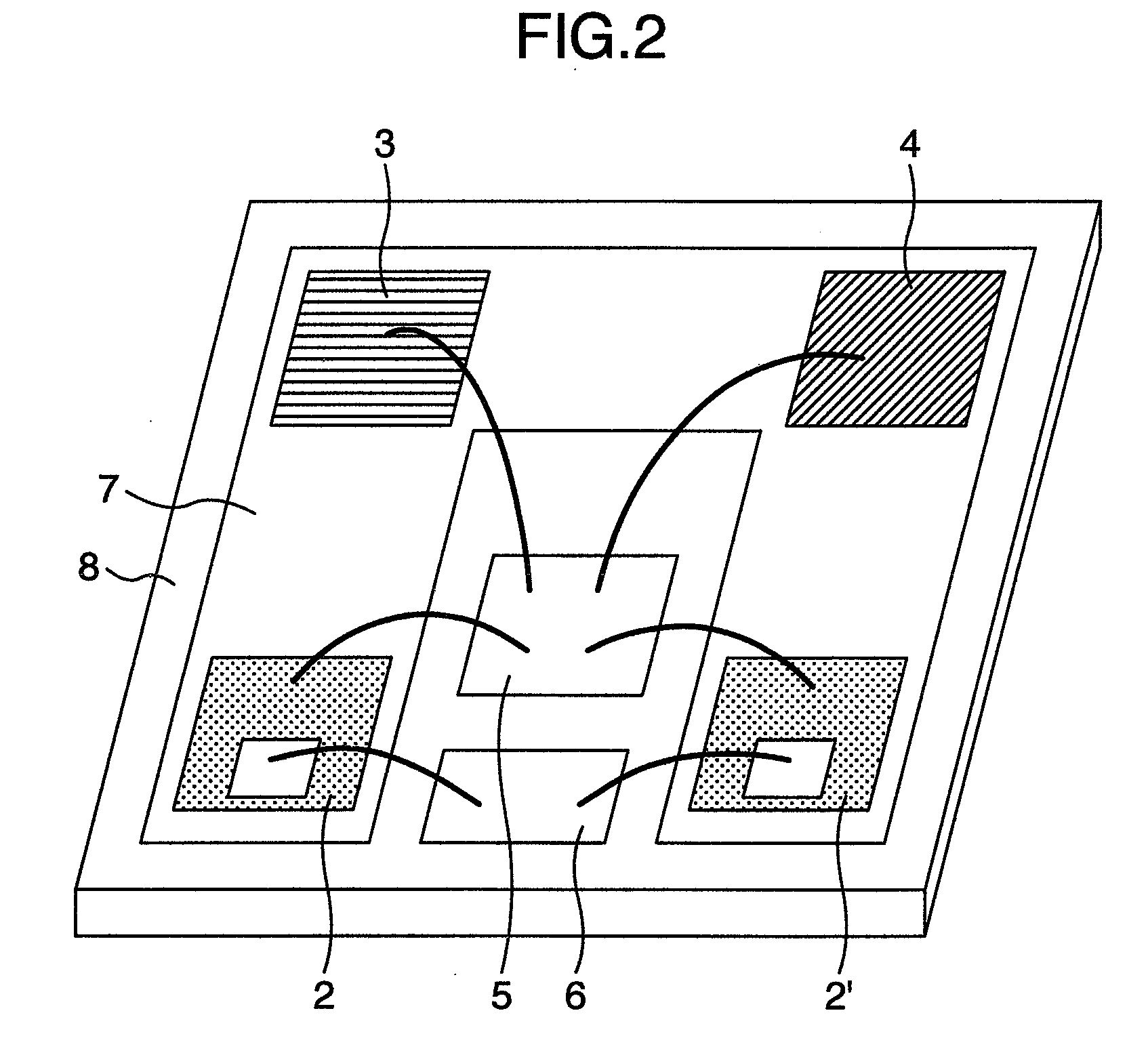Circuit device having a free wheeling diode, circuit device and power converter using diodes
a diode and circuit device technology, applied in the direction of diodes, electronic switching, pulse technique, etc., can solve the problems of increasing the switching loss, difficult to largely reduce the recovery current in the current state, and the carrier stored in the diode to be discharged
- Summary
- Abstract
- Description
- Claims
- Application Information
AI Technical Summary
Problems solved by technology
Method used
Image
Examples
first embodiment
1. First Embodiment
[0056]Explanation will first be made as to the first embodiment. The present embodiment is directed to a circuit device which includes at least one switching element and at least one free wheeling diode connected in parallel thereto, wherein a Schottky barrier diode and a silicon PiN diode having a semiconductor material with a band gap larger than silicon as a base material are connected in parallel, and the Schottky barrier diode and the silicon PiN diode are provided in the form of separate chips. The semiconductor material having a band gap larger than silicon is made of silicon carbide (SiC) as a typical example. The semiconductor material may also be made of gallium nitride (GaN). The free wheeling diode plays a role of holding a characteristic voltage and passing a current necessary for a load when the switching element is turned OFF by smoothing an abrupt variation in a circuit caused by the switching operation of the switching element, that is, plays a ro...
second embodiment
2. Second Embodiment
[0064]A second embodiment will next be explained.
[0065]The present embodiment is directed, as an example, to a circuit device which includes at least one switching element and a free wheeling diode connected in parallel to the switching element, wherein the free wheeling diode is made up of a Schottky barrier diode having a base material with a band gap larger than silicon and two or more PiN diodes connected in series therewith, the PiN diode uses a semiconductor material having a band gap larger than silicon as its base material, and the Schottky barrier diode and the PiN diode are provided in the form of separate chips.
[0066]FIG. 7 shows part of an inverter circuit to which a power module is applied in the second embodiment. FIG. 7 is different from the example of FIG. 1 in two first and second respects, that is, in that (1), as the first respect, a PiN diode made of a semiconductor material having a band gap larger than silicon is used in place of the PiN dio...
third embodiment
3. Third Embodiment
[0069]The arrangement of a converter circuit in accordance with a third embodiment of the present invention will be explained by referring to the drawings.
[0070]FIG. 10 shows a basic circuit in the arrangement of the converter circuit of the present invention. In FIG. 10, the basic circuit includes a first switching element 201, a first Schottky diode 202, a first capacitance 203, a first resistance 204, a positive side inductance 205, an AC terminal 206, a circuit positive terminal 207, a circuit negative terminal 208, a switching element 211 for the first Schottky diode 202, a second Schottky diode 212, a second capacitance 213, a second resistance 214, and a negative side inductance 215.
[0071]The circuit of the present embodiment will be explained with reference to FIG. 10.
[0072]FIG. 10 shows a basic circuit of a combination of the diodes and the switching elements forming the converter circuit. A combination of such basic circuits is used as a converter circui...
PUM
 Login to View More
Login to View More Abstract
Description
Claims
Application Information
 Login to View More
Login to View More - R&D
- Intellectual Property
- Life Sciences
- Materials
- Tech Scout
- Unparalleled Data Quality
- Higher Quality Content
- 60% Fewer Hallucinations
Browse by: Latest US Patents, China's latest patents, Technical Efficacy Thesaurus, Application Domain, Technology Topic, Popular Technical Reports.
© 2025 PatSnap. All rights reserved.Legal|Privacy policy|Modern Slavery Act Transparency Statement|Sitemap|About US| Contact US: help@patsnap.com



